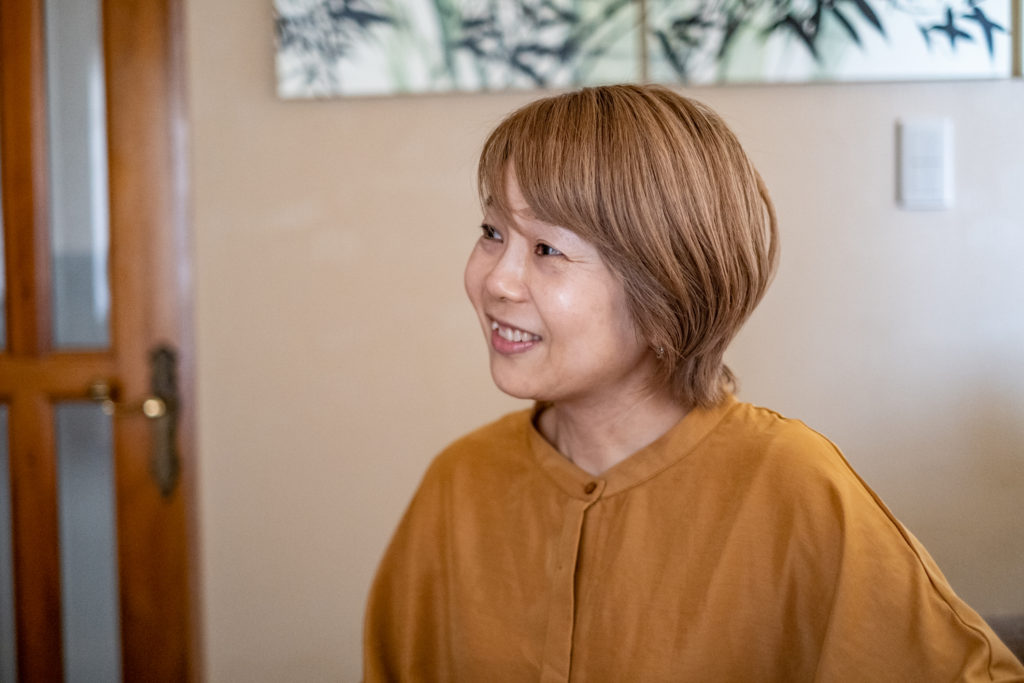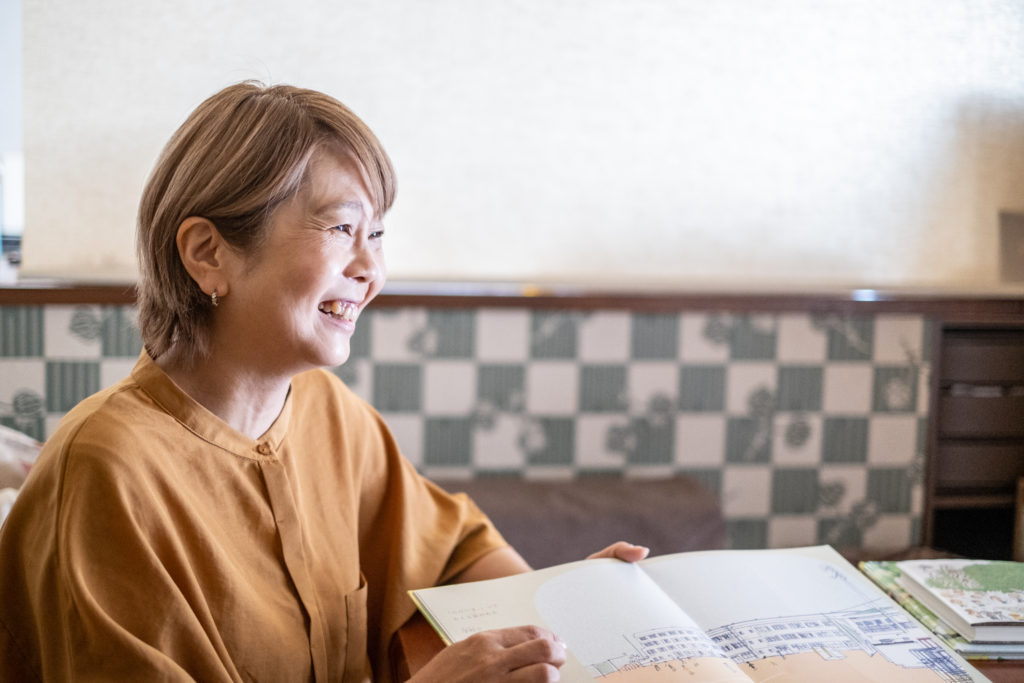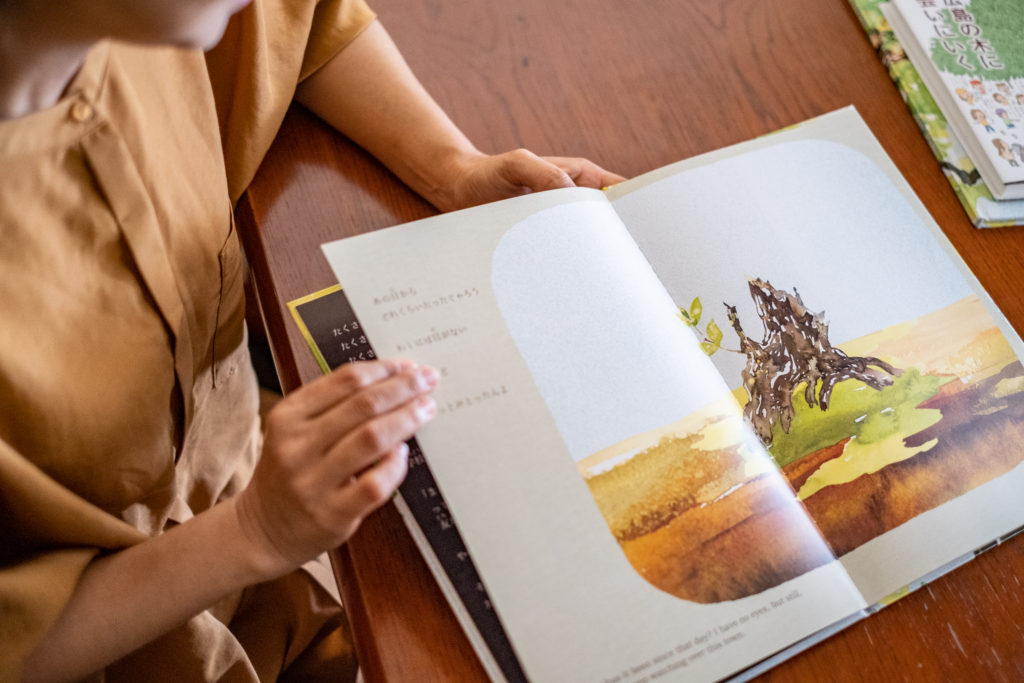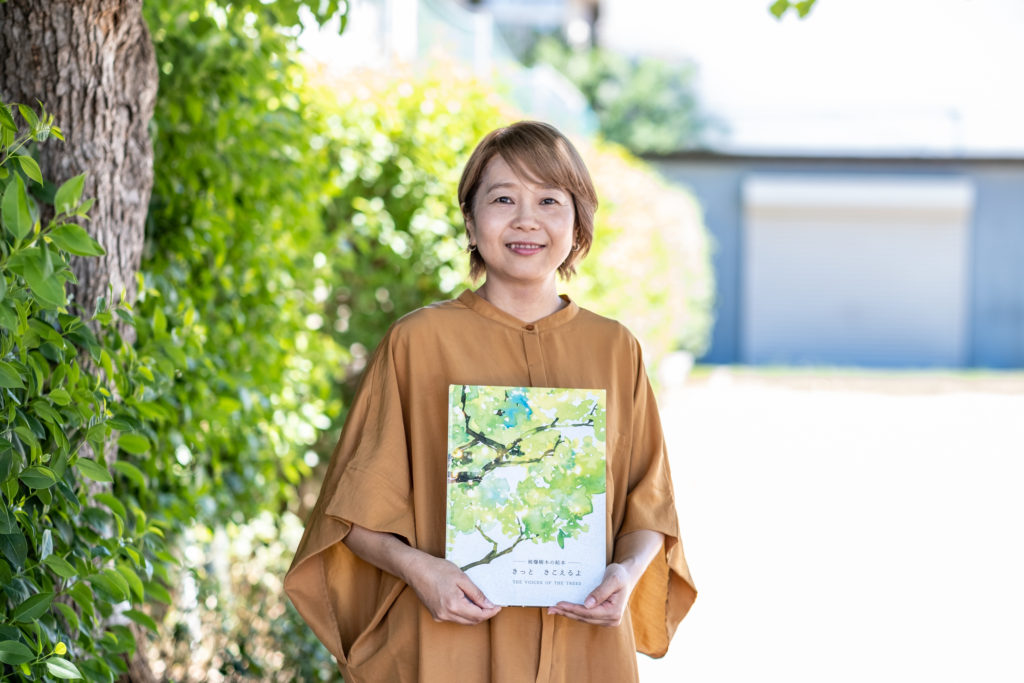Think about the part you can play to promote peace, and take action: What I have learned through creating a picture book

There are many picture books on the themes of “war” and “peace” in Japan and abroad, including one published here in Hiroshima on the theme of the hibakujumoku, or A-bombed trees, trees that survived the atomic bombing of the city. It is called “The Voices of the Trees”. The authors are two mothers who have been participating in a picture book reading group for many years. We spoke with Mika Fujiwara, one of the authors, about the story behind the book’s creation.
The author, Mika Fujiwara, is a former nursery school teacher. She has been active in a group that reads to children at Midorimachi Elementary School in the city of Hiroshima, where her own child was a student. One day, the school’s PTC (parent-teacher club/committee/council, a group similar to a parent-teacher association (PTA)) held a “self-improvement seminar for parents,” to which Tomoko Watanabe, president of ANT-Hiroshima, was invited as a lecturer.
The organization is an NGO that conducts a wide range of international cooperation, international peace, and educational projects. On this occasion, Ms. Watanabe used a picture-story show to talk about the A-bombed trees. Ms. Fujiwara recalls, “To tell the truth, I was not familiar with peace education until then. I thought it was scary, and I was even afraid of it as a child.” However, after listening to Ms. Watanabe’s story, she became fascinated by the existence of the A-bombed trees. “What shocked me the most was the fact that some of the A-bombed trees were now tilted toward the direction of the A-bomb hypocenter,” she told us. “When Ms. Watanabe mentioned this, oddly enough, I felt as if I heard the voices of the A-bombed trees telling me ‘Discover who we are. Listen to our voices.’”

Ms. Fujiwara says she was driven by the voices of the A-bombed trees
After the seminar, Ms. Fujiwara paid a visit to Ms. Watanabe, hoping to use the same picture-story show for her reading group. Unfortunately, there was only one set of picture-cards available, and they could not be borrowed, but she received an unexpected suggestion: “Why don’t you try making your own picture-card show?” Ms. Fujiwara then contacted Mika Muramoto, a member of the same reading group, to tell her about the idea. This is when they came to the decision to produce a picture book under the pen name of “Wmika” (read “double Mika”).
The illustrations, which play a key role in the picture book, were commissioned from Hiroe Takigawa, an illustrator based in Hiroshima. After researching various artists, we were fascinated by the delicate touch of Ms. Takigawa’s illustrations, so much so that we thought, “This is the only person for the job”. Ms. Fujiwara explains that “although we had a limited budget, Ms. Takigawa generously took on the project because she believed in the purpose of the book.”

All the wonderful illustrations were done by Ms. Takigawa
Ms. Fujiwara and Ms. Muramoto visited most of the approximately 160 A-bombed trees during the one year and eight months they worked on the project. At times, they took their own children to see the trees. They also wrote the text by talking to local residents who were familiar with the trees before the bombing.
“We used the book, ‘A Trip to the Hiroshima Trees,’ written by Yuko Ishida and published by Kaiseisha, and the A-bombed trees map published by the Green Greetings Project (an initiative of the Hiroshima City Peace Promotion Department to support A-bombed tree preservation activities) as reference materials. These publications helped me to appreciate once again how many A-bombed trees with various stories still exist in Hiroshima,” she said. As they learned about the many different trees, Ms. Fujiwara and Ms. Muramoto were in perfect agreement on which trees “should be the main characters of the story.” They chose the camphor tree located in Hijiyama Park in Minami Ward and the Yoshino cherry tree located in the same park.
It is said that the large camphor tree, which is located far from the hypocenter, guarded those who fled from the war at that time. Ms. Fujiwara said that she was also struck by the sight of the Yoshino cherry tree, which seemed to be on the verge of withering, but still managed to bloom year after year.
The picture book features a story told by Ms. Watanabe about an A-bombed tree whose trunk leans in the direction of the hypocenter, as well as “basal shoots”, new shoots that grow from the base of a cut tree stump, which are a symbol of the reconstruction of the city. The artist in charge of the illustrations used various creative approaches to help tell the story, such as contrasting views, painted from the same angle, of the sparkling city of Hiroshima before the atomic bombing and the scorched ruins of the city after the bombing.
“I didn’t want it to be too scary, the way I used to find peace education scary,” she said. “I wanted the book to have a gentle feel, so that it would not be out of place in a book café or other such places. Our first goal was to get as many parents and children as possible to pick up the book,” explained Ms. Fujiwara about her intentions in creating the book.

Open space was left on all sides to make the book easy to read to children
The picture book was finalized in 2019 with the continued support of local residents and friends who had championed the project, and was donated to kindergartens, nursery schools, and elementary schools in Hiroshima’s Minami Ward, as well as to libraries throughout the city. The response to the book was so great that it was revised and a second edition was self-published and released for sale in 2020. The picture book is currently used at various schools for peace education, and was also selected to participate in the 2022 Sharjah International Book Fair held in Dubai, where it was made available to audiences outside Japan.
“Our goal was not to make a picture book, but to provide an opportunity for people to learn about the A-bombed trees and to think about peace. I think this picture book is the result of the power that the A-bombed trees gave us,” said Ms. Fujiwara. The book is often used in the reading groups’ activities, and she was delighted when she received comments from children saying, “I think the trees taught us that we should not make war.”
“Hope alone does not build peace. We are ordinary housewives with ordinary lives who had the opportunity to meet the A-bombed trees and create a picture book about them. I am sure that there are peace initiatives that you, too, can take part in. We hope that this picture book will inspire you to take action for peace, no matter how small the action may be.”
We all have a part to play in creating peace. Perhaps this picture book about A-bombed trees can help us find out what our part can be.

Contact information
“The Voices of the Trees”
Wmika (Mika Fujiwara)
080-5238-1288
Online store: https://voices-of-the-trees.jimdofree.com/
Related articles
Meeting Trees: Sending Trees that Survived Atomic Bombing from Hiroshima to the World
Sharing the Story of A-bombed Trees With As Many People As Possible
Tags associated with this article








